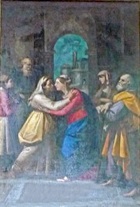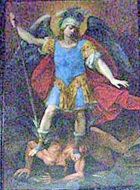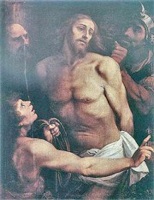
Mocking of Christ (ca. 1598)
Chiesa di S. Carlo ai Catinari, Rome
Giuseppe Cesari was born in Arpino, south of Rome. He moved to Rome with his family, and made his name there at an early age. He became a member of the Accademia di San Luca in 1585 and was president on three occasions: in 1599, 1605 and 1629.
Caravaggio worked in his studio as a painter of fruit and flowers in 1593-4. His other students included Francesco Alegrino.
The Cavalier d’ Arpino was probably the most important artist in Rome during first two decades of the 17th century, when he enjoyed the esteem and patronage of Pope Clement VIII. He designed of the mosaics (1603-12) for the dome of St Peter's and was knighted by Clement VIII during the Jubilee celebrations of 1600, in recognition of his work in San Giovanni in Laterano, Rome.
In 1607, Pope Paul V gave 107 paintings that had been confiscated in lieu of taxes from the studio of the Cavalier d’ Arpino to his nephew, Cardinal Scipione Borghese.
Amelia
Fresco (17th century)
The frescoes in the ex-church of Sant’ Angelo, which were attributed to the Cavalier d’ Arpino, have been destroyed.
Foligno
Copy of the Foligno Madonna (17th century)
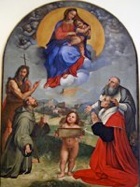
Narni
Visitation (early 17th century)
Perugia
Copy (1609) of Raphael’s Baglioni Deposition
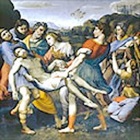
The copy was recorded:
-
✴near the Cappella dei Baldeschi, San Francesco al Prato in 1671:
-
✴above the high altar of the Oratorio di San Bernardino, in the original frame or perhaps a replica of it, in 1683;
-
✴above a door in the chapel in San Franceso al Prato that had originally housed the original (still as part of a reconstruction of the original) in 1784 and 1787.
Although it was listed among works to be sent to the Musei Capitolini, Rome in 1812, it was subsequently decided that it should remain in the church. It entered the Galleria Nazionale in 1863.
Spoleto
Annunciation and Assumption of the Virgin (ca. 1626)
These small panels by Giuseppe Cesari, il Cavalier d’ Arpino are to the sides of the altar in the Cappella delle SS Icone of the Duomo. The chapel had been inspired by the Borghese Chapel of Santa Maria Maggiore, Rome, in which the Cavalier d’ Arpino had also worked.
Christ the Redeemer with saints (ca. 1600)
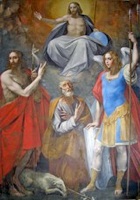
Terni
St Michael crushes demons (ca. 1630)


